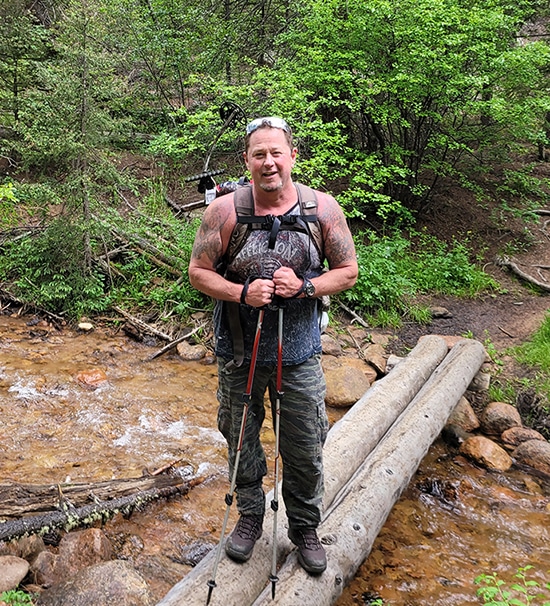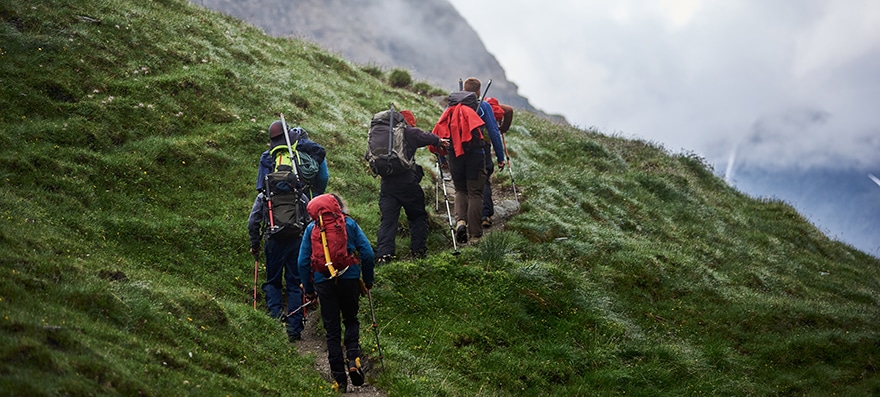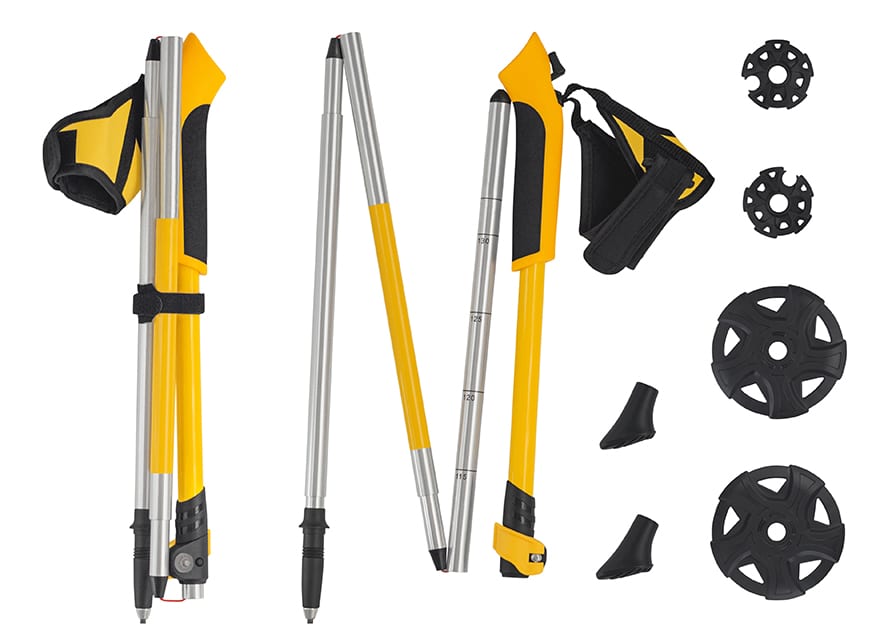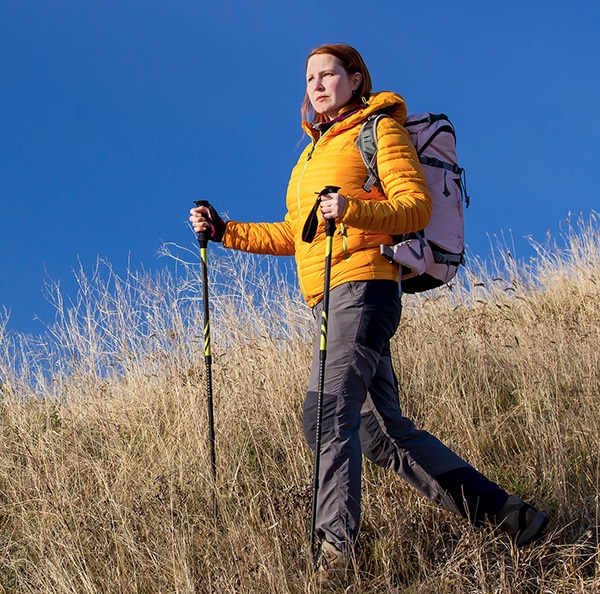Backpacking with Poles: Unleashing the Power of Trekking Poles
Hiking and backpacking are two activities I’ve always enjoyed and do as often as possible when prepping for an upcoming hunt. Both are great for scouting trails and for getting fine-tuned on physical conditioning. There’s something incredibly exhilarating about venturing into the great outdoors. In all the years I’ve been hiking and backpacking, I never felt the need to learn more about using Trekking Poles for backpacking until recently.

I know the importance of having the right gear and how it can improve comfort, stability, and overall enjoyment during backpacking trips. And now, almost as high importance as the right boots, I have added this essential piece of equipment to my list.
In this blog post, I want to share my experiences and insights about using poles for backpacking, from their benefits and proper usage to essential tips and FAQs. So, grab your backpack, and let’s dive into the world of trekking poles!
Table of contents
- Backpacking with Poles: Unleashing the Power of Trekking Poles
- Benefits of Trekking Poles
- Popular Tip Types and When to Use Them
- Types of Trekking Poles and Their Applications
- Proper Usage and Technique
- One or Two Poles
- Essential Tips for Backpacking with Poles
- Using Trekking Poles for Backpacking Conclusion
- Using Trekking Poles for Backpacking FAQs
Benefits of Trekking Poles

Increased Stability and Balance
One of the primary advantages of using trekking poles during backpacking is the increased stability and balance they provide. When traversing challenging terrains or crossing uneven surfaces, the poles act as additional points of contact with the ground, helping to distribute weight more evenly. When wearing a heavy pack, this is even more important. This added stability can prevent slips, trips, and falls, reducing the risk of injuries.
Reduced Strain on Joints
Backpacking often involves carrying a heavy load on your back for extended periods. Trekking poles can help alleviate the strain on your joints, particularly in your knees and ankles. Transferring some weight to the poles can lessen the impact on your lower body, allowing you to hike longer and with less discomfort.
Enhanced Endurance
Trekking poles engage your upper body muscles, effectively distributing the workload and reducing fatigue. This balanced exertion can enhance your endurance, allowing you to tackle longer distances and steeper inclines without feeling as drained.
Quicker Ascents and Descents
Trekking poles can be a game-changer when faced with steep ascents or descents. You can propel yourself forward or slow down your descent by planting the poles firmly into the ground and leveraging your upper body strength. This technique helps maintain control, especially when navigating tricky or slippery slopes.
Joint-Friendly Descents
Walking downhill can be tough on the knees, causing discomfort and soreness. By utilizing trekking poles, you can distribute your weight more evenly, easing the strain on your joints and reducing the impact of each step. This can be particularly beneficial during long descents, ensuring you reach your destination with less fatigue and discomfort. As many know, this makes a difference on long multi-day hikes or when carrying extra weight, hauling out the game when hunting.
Popular Tip Types and When to Use Them
Trekking poles come with various tip options for different terrains and hiking conditions. Choosing the right tip can significantly enhance your trekking experience. Here are some popular tip types and when to use them:

Standard Tip
The standard tip, typically made of carbide or steel, is the most common and versatile option. It provides excellent traction on most terrains, including dirt trails, water crossings, rocky surfaces, and even icy or snowy conditions. The standard tip is a reliable choice for general backpacking and hiking adventures.
Rubber Tip
Rubber tips are often used for indoor or urban environments, such as walking on pavement or gymnasium floors. They offer improved grip on hard surfaces, minimize noise, and prevent the tips from causing damage or leaving marks. Rubber tips can also be beneficial when hiking on delicate or fragile terrains to reduce impact.
Mud/Snow Basket
Mud or snow baskets attach to the bottom of the trekking pole tip and provide additional surface area to prevent the poles from sinking into soft ground or deep snow. These baskets are especially useful during muddy or snowy conditions, allowing you to maintain stability and reduce effort. Mud/snow baskets are easily removable, making them convenient for transitioning between different terrains.
Trekking Pole Boot
A trekking pole boot is a large, rounded rubber cap that fits over the standard tip. It provides extra grip on rocky surfaces, protects the tip from wear, and reduces noise. Trekking pole boots are commonly used in alpine environments or when hiking on rugged, uneven terrains.
Carbide Tip Protector
A carbide tip protector is a small rubber cap that fits over the carbide tip. It is a protective cover when trekking poles are unused or when navigating delicate surfaces, such as wooden boardwalks or indoor areas. The carbide tip protector helps prevent damage to the tip and ensures a quieter experience.
Types of Trekking Poles and Their Applications
Trekking poles come in various types, each designed to cater to different hiking styles, terrain types, and personal preferences. Understanding the different types of trekking poles available can help you choose the right ones for your specific needs. Here are some common types of trekking poles and their applications:

Telescopic Trekking Poles
Telescopic trekking poles are the most popular and versatile type. They consist of adjustable sections that can be lengthened or shortened to suit your height and the terrain you’re hiking. Telescopic poles are highly adjustable, making them suitable for hikers of different heights and allowing for easy packing and storage. They are ideal for various terrains, from flat trails to steep ascents and descents.
Folding Trekking Poles
Folding trekking poles, or collapsible poles, are designed with multiple sections that collapse into a compact size. These poles are lightweight and packable, making them great for backpackers who prioritize saving space and weight in their gear. Folding poles are often lightweight materials like carbon fiber or aluminum alloy. While they may not offer the same level of adjustability as telescopic poles, they are convenient for hikers who value compactness and ease of transportation.
Fixed-Length Trekking Poles
Fixed-length trekking poles are poles with a predetermined, non-adjustable length. They are typically lighter and more durable than telescopic poles due to their more straightforward design. Fixed-length poles are favored by ultralight backpackers and thru-hikers who prioritize weight savings. However, they require precise sizing to ensure a proper fit, and they may not be as versatile in accommodating different hiking conditions.
Ultralight Trekking Poles
Ultralight trekking poles are designed to be as lightweight as possible without compromising strength and durability. They are often made of lightweight materials like carbon fiber, which reduces overall weight while maintaining adequate strength. Ultralight poles are popular among backpackers who aim to minimize the weight of their gear for long-distance or multi-day hikes. However, it’s important to note that ultralight poles may sacrifice some durability compared to heavier options and tend to run pricier.
Shock-Absorbing Trekking Poles
Shock-absorbing trekking poles are equipped with built-in mechanisms that dampen and absorb the impact from each pole plant. Typically located in the lower pole section, these mechanisms use springs or elastomers to absorb shocks and reduce strain on your joints. Shock-absorbing poles are particularly beneficial for hikers with sensitive wrists, elbows, shoulders or those who frequently hike on hard surfaces or downhill sections. However, they may add some weight and complexity to the poles.
Winter/Snow Trekking Poles
Winter or snow trekking poles are specialized for snowy and icy conditions. These poles often have larger baskets, typically known as snow baskets, which prevent the poles from sinking too deeply into the snow. They may also feature wider, more robust tips for improved traction on icy surfaces. Winter trekking poles are essential for snowshoeing, winter hiking, or mountaineering adventures, where stability and traction are crucial.
Pole Type Considerations

When choosing trekking poles, consider the type of terrain you’ll be hiking, your hiking style, and any specific requirements you have. The type of trekking poles you select can significantly impact your comfort, stability, and overall enjoyment during your backpacking trips.
Remember to test and adjust your trekking poles before embarking on a long hike to ensure they are the right fit and length for your height and preferences.
Proper Usage and Technique
Now that we’ve explored the advantages of using trekking poles for backpacking, it’s crucial to understand how to use them correctly to maximize their benefits. Here are some essential tips and techniques to keep in mind:

Adjusting Pole Length
Most trekking poles come with adjustable shafts, allowing you to set the length according to your height and the terrain you’re hiking. Generally, your elbows should be bent at a comfortable angle of about 90 degrees when holding the poles. Experiment with different lengths to find what feels most natural and comfortable. If you feel the pole length is incorrect, consider resizing them when you stop to eat or rest.
Grip and Wrist Strap Placement
When holding the poles, grip them firmly but without tensing your muscles excessively. The straps on the poles are designed to support your wrists and prevent you from dropping the poles accidentally. To use the wrist straps effectively, slide your hand up through the straps from underneath, allowing the strap to rest comfortably on the back of your hand. Using the straps correctly allows you to transfer weight to your wrists, reducing strain on your grip.
Planting and Swinging Technique
To get the most out of your trekking poles, it’s crucial to master the planting and swinging technique. As you walk, plant the poles slightly ahead of you and diagonally opposite to your feet, providing support and stability. As you step forward, swing your arms naturally, allowing the poles to move with your stride. This synchronized motion helps maintain a steady rhythm and balance, making your hiking experience more efficient.
Uphill and Downhill Techniques
When hiking uphill, shorten your pole length slightly to help propel yourself forward. Plant the poles firmly into the ground and use your upper body strength to assist your legs. On downhill sections, lengthen the poles to provide additional stability. Focus on planting the poles before you to control your descent and reduce strain on your knees.
Pace and Cadence
You’ll find your natural pace and cadence as you become more comfortable with trekking poles. Let the poles dictate the rhythm of your hike, allowing you to move smoothly and efficiently. Remember to take breaks when needed, listen to your body, and adapt your pace to the terrain and weather conditions.
One or Two Poles
The choice between using one or two trekking poles depends on personal preference and the specific needs of the hike. Here are some key differences to consider:
One Trekking Pole

A single trekking pole can provide stability and support, particularly when hiking on moderate terrain. It can be helpful for those who prefer having one hand free, such as photographers, carrying binoculars, or individuals who need to use their hands for other activities. However, using one pole may not provide as much
balance and stability as using two poles, especially on challenging or technical terrain.
Two Trekking Poles
Using a pair of trekking poles maximizes stability, balance, and weight distribution. This configuration is particularly beneficial for steep ascents and descents, uneven terrain, or carrying a heavy backpack. Two poles provide symmetrical support, engaging both arms and the upper body, resulting in improved posture and reduced strain on joints. They also offer increased stability during creek crossings and can serve as tent poles for ultralight backpacking.
Ultimately, the decision between one or two trekking poles is a personal preference, and it may be worthwhile to try both configurations and determine which option works best for you and the specific conditions of your hike.
Essential Tips for Backpacking with Poles
Here are a few additional tips that can enhance your backpacking experience when using trekking poles:

Maintenance and Care
Regularly inspect your trekking poles for any signs of wear and tear. Clean them after each trip, especially if you encounter muddy or sandy conditions. Lubricate the locking mechanisms and joints periodically to ensure smooth adjustments and prevent rust. Storing your poles in a dry, cool place will help prolong their lifespan.
Terrain Considerations
While trekking poles are versatile and can be used in various terrains, there may be instances when they are less beneficial or unnecessary. On extremely technical terrain, such as rock scrambling or steep climbs requiring the use of hands, you may find it more practical to stow your poles temporarily. Assess the conditions and adjust your pole usage accordingly.
Packing and Weight Distribution
Remember the straps and any potential interference with your pole movements when attaching your backpack. Make sure your poles are secured to your backpack or readily accessible from the outside, depending on your preference. Distribute the weight evenly between your backpack and poles to maintain balance and stability.
Using Trekking Poles for Backpacking Conclusion
After decades of backpacking adventures, I can confidently say that trekking poles have become a staple in my gear lineup. They provide stability, reduce strain on my joints, and enhance my overall endurance. Whether traversing rugged terrains or conquering challenging ascents and descents, my trekking poles have supported me every step. I encourage fellow outdoor enthusiasts to consider incorporating trekking poles into their backpacking gear, as they can significantly enhance your hiking experience and open up new possibilities on the trail.
Using Trekking Poles for Backpacking FAQs
Yes, trekking poles can be used in all seasons. However, during winter hiking or mountaineering, you may consider using snow baskets or attaching them to your trekking poles to prevent them from sinking into the snow.
Absolutely! Trekking poles can benefit hikers of all fitness levels. They provide added stability and help reduce strain on joints, making them a valuable tool for both beginners and experienced hikers alike.
Trekking poles can be especially beneficial if you have a pre-existing knee injury. They help distribute weight and reduce impact, minimizing strain on your knees during hikes.
While trekking poles are often associated with steep ascents and descents, they can also be used on flat terrain. Even on level ground, trekking poles offer increased stability, reduced joint strain, and improved posture. They can help balance during river crossings, traversing muddy sections, or walking on uneven surfaces. Additionally, trekking poles can provide extra support when carrying a heavy backpack, distributing the weight more evenly and reducing fatigue.
The choice between using one or two trekking poles depends on personal preference and the specific needs of the hike. Here are some key differences to consider:



